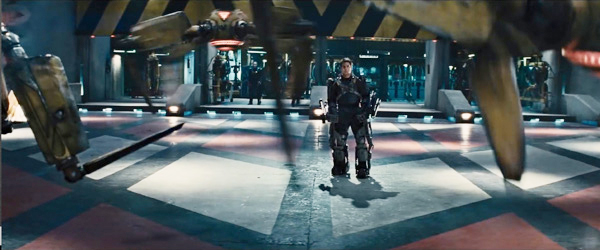Cinesite built robotic aliens and a training range where the hero of ‘Edge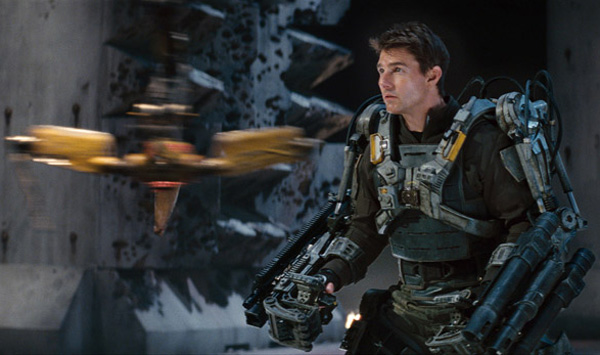
of Tomorrow’ hones his battle skills, and created a time slice shot combining
motion control and post camera moves.
Cinesite Builds a Robotic Boot Camp on ‘Edge of Tomorrow’ |
| As the pace of the story in the sci-fi action movie ‘Edge of Tomorrow’ picks up, it includes a complex, fast-moving sequence in which the hero, officer William Cage, endures a harsh and rigorous series of training sessions in which he battles against robotic versions of the story’s vicious aliens, called Mimics, to perfect his fighting skills. |
 |
|
The timing of the award allowed Cinesite’s team no chance for on-set supervision or survey, but previs had been prepared and cut into the footage as an editorial guide. Because the robot animation and environment extension work had to precisely match the live action performance and the camera moves, their work started by blocking out each shot as an initial pass. Motion Studies“We weren’t building any robots yet but wanted to figure out the motion,” saidCinesite VFX supervisor Simon Stanley-Clamp. “Whenever Cage gets struck and thrown across the training room, used as a shooting range, marks the moment and position that we need to work to. That showed us, for example, that the robot would get from this point to that point in X number of frames. From there we created a walking pass to get our animation signed off, and finalized the layout.” |
 |
|
Motion studies for the robots continued over a four to six-week period, while they experimented with blade shapes and design. Articulated and spinning extremely fast, these blades could be made to look quite aggressive, like a tarantula. The boot-up time and overall speed were important to convey their construction – electronics combined with a gyroscope – and weight. The spinning had to be fast enough to look threatening but not so speedy that they lost their weighty feel. “The range environment is like the inside of a massive industrial hanger,” said Simon. “In keeping with this, I wanted the surfaces on the Mimic robots to resemble a beaten up, rusted yellow cab. When they break they are mended crudely, with new parts roughly bolted on, and the bumps and scratches remain visible. I heightened the textures so they would stand out against the dull background.” |
|
|
Low-Tech and DeadlyConcurrently, Simon worked on the environment, a large, well-worn warehouse-like interior space with gritty concrete walls and floor, lined with heavy pieces of military machinery. The look was functional and low-tech. All the action occurs within this space to which the team added a ceiling, extended corridors and replicated the mechanical props, tweaking everything for continuity and all camera moves. Therefore, the environment, rigging and blocking developed approximately at the same time. The robots also have lights that a trainee fires at and hits, indicating that the ‘alien’ has been struck down. “We made the lights work similarly to brake lights on a car, with the brightness of LEDs, and streak nicely as they spun and rushed around the set. We also took the triangular shaped light from the art department’s concept and inverted it. Positioned between two hinges of the blades, it creates a face-like outline for Cage to fire at. “We did not have any real cues on set to sync to for the interactions. There were markers on set for eyelines and a puff of air blowing on Cage when a robot was meant to spin past him, but no lights on set for interactive lighting. We graded his face, timed with the muzzle flashes from his gun and the lights on the robots. |
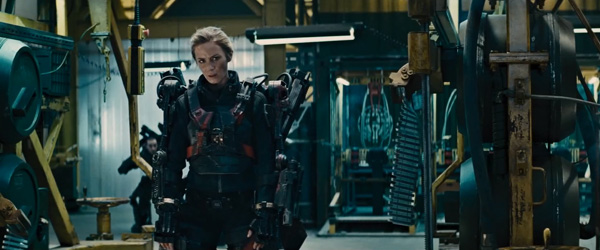 |
Motion BlurAdjusting the motion blur was important – we reduced it at certain times enough for the audience to understand the action and how it worked, but then restored the physically correct motion blur for realism. The actor was thrown about the set on a jerk rig that pulled him backwards violently, and that meant heavy rig and cable removal for the Cinesite’s artists. If pieces of his armour break off as a result, they created and animated these in CG, and when the metallic blades strike his exosuit or he scrapes across the floor, they added flying sparks. “We created some single-frame digital takeovers of Cage during several of these strikes to put more depth into the action. Cage’s double came to us from Sony and worked pretty well in our pipeline. We were also able to up-res the model for close-ups and clean-up. It was essential that the exosuit he wore felt heavy. That is, when he is hit, the animation needed to show that the impact is big, but he can’t simply fly backwards. “We had to show a heavy, clunky landing – it was a combination of good stunt work and accurate rigging in the takeovers. Once or twice the action flows from live action, then to CG after the strike, then back to live action for the landing. Having a coherent sequence like this gives the team a chance to refine the render and compositing pipeline until we have a portfolio of reference shots to work for consistent grading, glows and colours across all of the shots.” |
 |
|
A Moment in TimeWhen the story moves to an underground car park below the ministry of defense, where the two main characters are being chased in a Jaguar, the action suddenly comes to a virtual standstill while Cage experiences a momentary vision. The car and actors were shot with a motion control camera intending to drop it as an element back into footage of the garage set to continue the shot, but the production had not actually captured the material for these shots. So Cinesite went back to the location to carry out their own stills shoot, intending to re-build the garage through projections. “I was expecting the garage to be full of cars, as it was in the main shoot but it was completely empty. So we shot our stills and then had to re-populate the space with about 50 CG photoreal cars to match those in the surrounding shots. |
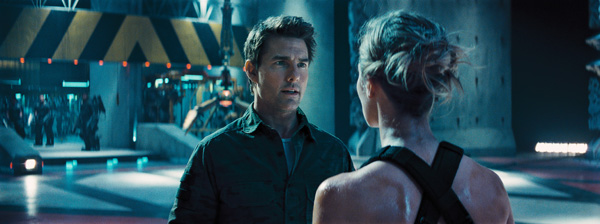 |
|
“However, because we had done our own stills and HDRI shoot we had everything we needed for re-projecting lighting effects onto the car and all reflections through the car park. It required some big renders to produce an ordinary, mundane look.” Driver’s SeatDuring the time slice, Rita sits completely still in the driver’s seat while Cage moves in real time. They froze all CG surrounding objects and took the camera move around the car, out of the motion control and back onto their environment. The whole shot comprises about 800 frames, on which they put a heavy re-speed to produce the desired effect. |
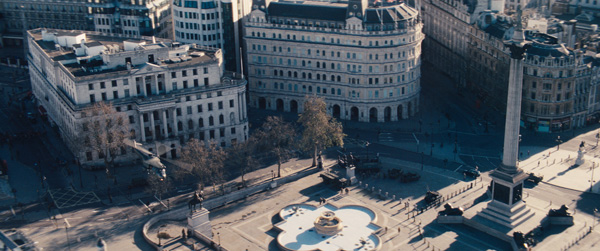 |
|
One of these was an introductory shot into the huge workshop where the soldiers’ exosuits are repaired. The camera starts high and tilts down into the workshop where half the background is occupied by green screen. The team extended the set back indefinitely and upwards into the very high ceiling, replicated the containers and added quite a few digital doubles and silhouettes to augment the people there, welding and working. In Trafalgar Square, where Cage lands in an aircraft at the beginning and end of the story, they performed all clean-ups, adjusted the time on Big Ben and positioned the massive hero poster of Rita on the exterior of the building. www.cinesite.com |


